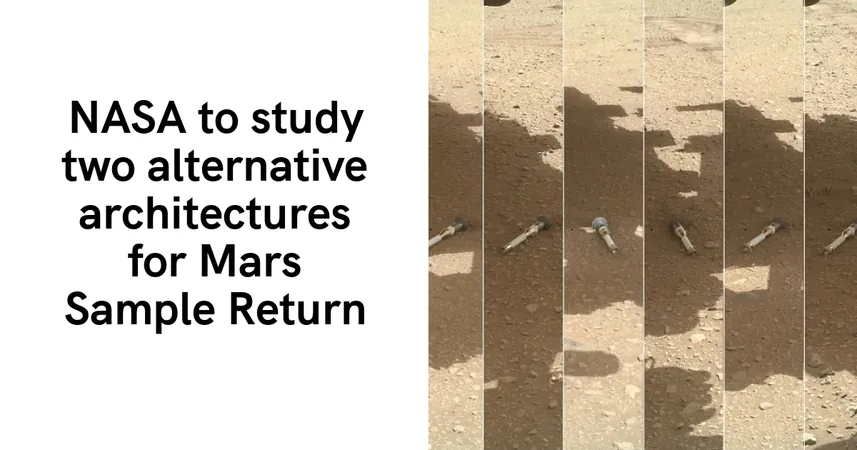
NASA's Innovative Mars Sample Return Mission: Two Groundbreaking Approaches After 2025
2025-01-07
Author: Amelia
Introduction
In a bold step for interplanetary exploration, NASA has unveiled plans to spend the next 18 months rigorously studying two distinct strategies for returning Martian samples to Earth. This ambitious initiative aims to bring back samples collected by the Perseverance rover as early as 2035, leveraging both tried-and-true technology and innovative commercial collaborations.
NASA's Commitment and Plans
NASA Administrator Bill Nelson highlighted the agency's commitment to exploring these two architectural pathways, focusing on the delivery methods for a redesigned sample retrieval lander.
This lander will be tasked with transporting samples from Perseverance to the Mars Ascent Vehicle (MAV), which will then launch these priceless specimens into orbit, ready for collection by the European Space Agency's Earth Return Orbiter.
Proposed Options
The first proposed option involves utilizing the "sky crane" technology—successfully employed in previous Mars missions, including those of the Curiosity and Perseverance rovers. This approach is projected to cost between $6.6 billion and $7.7 billion. NASA's Jet Propulsion Laboratory has suggested that modifying this landing technology to accommodate a smaller MAV could significantly slash the overall expenses of the Mars Sample Return initiative, perhaps even halving initial budget estimates.
In contrast, the second approach, with cost projections ranging from $5.8 billion to $7.1 billion, seeks to utilize commercially developed "heavy landers." Although the particulars of these commercial vehicles remain under wraps, companies such as Blue Origin and SpaceX had previously received contracts to develop concepts utilizing their lunar landers, Blue Moon and Starship, respectively.
Technical Distinctions and Innovations
Nicky Fox, NASA's associate administrator for science, emphasized the critical distinction between the two options lies in their landing mechanisms. Both options aim to incorporate an advanced landing platform equipped with a radioisotope thermoelectric generator (RTG) for reliable power, sidestepping the challenges posed by dust storms that can hinder solar panels.
Furthermore, the redesigned sample-retrieval system aims to ensure planetary protection, preventing potential contamination while moving samples from the Perseverance rover to the lander. This meticulous planning will ease the transition to the Earth Return Orbiter, where the samples will ultimately be housed.
Timeline and Funding
NASA's timeline is ambitious yet realistic, with plans to finalize these architectures by mid-2026. The fiscal health of this endeavor, however, depends heavily on Congressional support. Initial funding requests were modest, but Nelson stressed the need for at least $300 million to get started, especially after past budget setbacks. He urged legislators to consider boosting allocations if they wish to expedite this groundbreaking mission.
International Competition and Scientific Potential
As exciting as NASA's plans are, international competition is heating up, particularly with China's forthcoming Mars Sample Return mission potentially launching as soon as 2028. While Nelson acknowledged the rivalry, he argued that the scientific rigor of NASA's efforts—focused on comprehensive sample analysis—far surpasses what the Chinese plan offers.
Laurie Leshin, director of JPL, emphasized the immense scientific potential contained within the samples collected by Perseverance. She highlighted the possibility of discovering "ancient biosignatures" within these specimens, which could offer critical clues about the potential for life on Mars. "Our job is to go get it," she declared confidently.
Conclusion
As NASA embarks on this thrilling journey, the world watches eagerly, hoping to uncover the secrets of the Red Planet's history and perhaps, its potential for harboring life.









 Brasil (PT)
Brasil (PT)
 Canada (EN)
Canada (EN)
 Chile (ES)
Chile (ES)
 Česko (CS)
Česko (CS)
 대한민국 (KO)
대한민국 (KO)
 España (ES)
España (ES)
 France (FR)
France (FR)
 Hong Kong (EN)
Hong Kong (EN)
 Italia (IT)
Italia (IT)
 日本 (JA)
日本 (JA)
 Magyarország (HU)
Magyarország (HU)
 Norge (NO)
Norge (NO)
 Polska (PL)
Polska (PL)
 Schweiz (DE)
Schweiz (DE)
 Singapore (EN)
Singapore (EN)
 Sverige (SV)
Sverige (SV)
 Suomi (FI)
Suomi (FI)
 Türkiye (TR)
Türkiye (TR)
 الإمارات العربية المتحدة (AR)
الإمارات العربية المتحدة (AR)